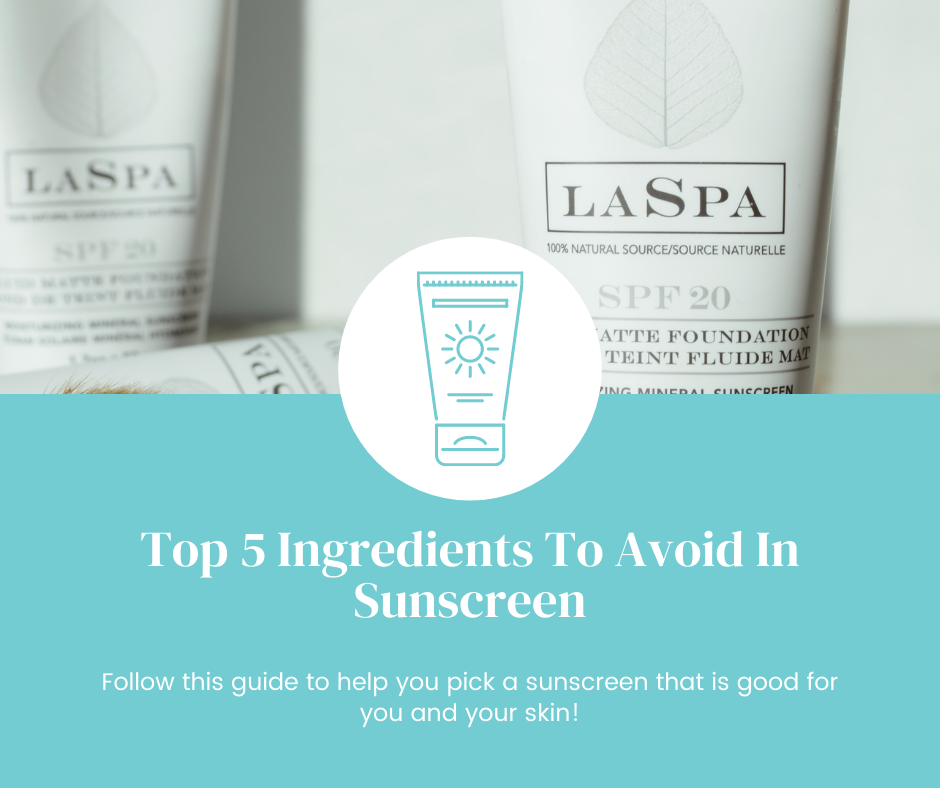

When we think of which beauty products we use most frequently, there will be a few that top the list. Perhaps body lotion, shampoo, deodorant, or moisturizer comes to mind first. But there’s one item that we use on a daily basis that is often overlooked: SPF Sunscreens.
Due to the fact that we use SPF sunscreens so often in our routines, we want to ensure we are selecting sun products that contain safe, skin-loving ingredients. It can be tough to make sense of complicated ingredients lists, so we’ve included a collection of our top ingredients to steer clear from.
What Ingredients To Avoid in SPF Sunscreens
1. Oxybenzone
Oxybenzone has been a topic of discussion for years, and it is one of the most popular sunscreen ingredients on the market. According to the Environmental Working Group, Oxybenzone:
- Has been linked to damage in coral reefs and other sea life
- Is easily absorbed by our skin and has been known to stay in our system for long periods of time
- Is being researched for endocrine and hormone disruption
2. Benzene
Benzene is a chemical commonly used for manufacturing plastics, pesticides, and even cigarettes. It’s not something that you would usually associate with personal care products.
Although the banned chemical benzene is not typically included in SPF sunscreens, scientific journal Valisure reports, “we’ve detected high levels of benzene, a known human carcinogen, in several brands and batches of sunscreen, which are considered drug products by the Food and Drug Administration (FDA), as well as in after-sun care products, which are generally regulated by FDA as cosmetics.”
This makes it more important than ever to ensure you are purchasing your SPF sunscreens from trusted sources.
3. Octinoxate
Octinoxate is another popular UV shield commonly used in chemical SPF sunscreens. EWG rates Octinoxate as a 5 on their Skin Deep toxicity scale, and it has been linked to reproductive and endocrine disruption. This means it can have negative hormonal effects on humans from topical application and marine life.
Although it’s most often found in SPF sunscreens, watch out for Octinoxate in nail polishes, cosmetics, and skincare items. It’s used to prolong product use and protect from sun deterioration over time.
4. Silicones
Companies use silicones in their formulas because of their silky, velvety texture. Although the smooth feel of silicones can be pleasing, the harm outweighs the benefits.
Silicones create a barrier on top of your skin that protects it from outside elements but can also trap dirt, makeup, sweat, and other fluids on top of your skin. Since silicones don’t allow your skin to properly breathe, they can cause acne, irritation, and skin dullness over time.
Silicones are considered a petrochemical product; they are created through a refining process with petroleum and natural gas. During this process, there is often cross-contamination of chemicals like formaldehyde and other toxins. This contamination can result in irritation and allergies when the products are applied on skin.
5. Fragrance
The ingredient “fragrance” seems harmless enough; we tend to think of fragrance as adding a pleasant scent to our favourite items. However, artificial fragrances are the most common allergen found in personal care products and are likely to cause skin irritation.
In addition, companies aren’t required to disclose which chemicals they include in their fragrance ingredient. There can be an array of unknown toxins in any proprietary fragrance blend.
Due to the potential for allergies, our products are created for sensitive skin with zero added fragrance.
Look For These Safe Alternatives
Zinc Oxide and Titanium Dioxide
These two SPF sunscreen ingredients create a physical barrier to block the sun’s harmful rays. They are often regarded as the two safest active sunscreen ingredients and protect against both UVA and UVB rays.
Out of the two, Zinc Oxide offers non-comedogenic coverage, meaning that it won’t clog your pores while shielding the sun. It blends easily into the skin and won’t leave a white cast.
All of our SPF sunscreens feature Zinc Oxide as the active ingredient for protection against sun rays.
Shea Butter
If you’re looking to replace that silky, smooth texture of silicone with a natural ingredient, Shea Butter will be your new go-to. Not only does Shea Butter contain essential fatty acids that moisturize and plump, but it has a buttery texture that melts easily into the skin.
Many consider Shea Butter to be a multi-purpose ingredient, and it has been used for centuries to moisturize skin, hair and nails with its deeply nourishing properties.
Shea Butter is a star ingredient in our SPF 20 Fluid Matte Foundation, a lightweight Tinted Moisturizer with SPF that offers a sheer layer of natural coverage.
Make Your Sunscreen Use Easy
Your personal care products should bring peace of mind. You shouldn’t have to think twice about whether an item is safe for you and your family. That’s why selecting natural products from trusted, transparent brands is so important.
At LASPA, we carefully craft and formulate all of our products with 100% natural, quality ingredients. You have enough things to worry about – sunscreen shouldn’t be one of them.
Why are natural ingredients important to you? Share your stories and connect with us on Instagram @laspanaturals!

